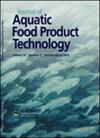利用基于1H核磁共振的代谢组学方法鉴定孟买鸭(Harpodon nehereus)内源性和人工甲醛生物标志物
IF 1.3
4区 农林科学
Q4 FOOD SCIENCE & TECHNOLOGY
引用次数: 0
摘要
甲醛可以通过酶促过程在水产品中内源性产生。然而,非法添加人造甲醛的做法在包括印度尼西亚在内的一些发展中国家仍然存在。本研究的目的是鉴定用于区分孟买鸭(Harpodon nehereus)作为样本渔业产品的内源性甲醛和人造甲醛的生物标志物。采用基于1H核磁共振的代谢组学方法鉴定样品中的代谢物。利用质子核磁共振对孟买鸭片样品进行代谢物分析,检测出11种代谢物(即乳酸、乙酸、氧化三甲胺(TMAO)、三甲胺(TMA)、二甲胺、赖氨酸、雁胺、肌苷、肌苷-5′-单磷酸肌苷和次黄嘌呤)。研究结果表明,该列表中的三种代谢物,即氧化三甲胺(TMAO)、三甲胺(TMA)和赖氨酸,可以作为区分孟买鸭鱼中内源甲醛和人工甲醛的指标。关键词:生物标志物甲醛鱼叉子代谢组学披露声明作者未报告潜在的利益冲突。本研究由2020年印尼教育捐赠基金(ldp)奖学金项目资助。我们特别感谢Sri Iswani,他协助我们进行了实验室分析。在研究和准备出版的过程中,作者Giri Rohmad Barokah一直是主要贡献者。本文章由计算机程序翻译,如有差异,请以英文原文为准。
Identification of Endogenous and Artificial Formaldehyde Biomarkers in Bombay Duck ( Harpodon nehereus ) Using 1H NMR-Based Metabolomics Approach
ABSTRACTFormaldehyde can occur endogenously in fisheries products by enzymatic processes. However, the practice of illegally adding artificial formaldehyde still occurs in several developing countries, including Indonesia. The aim of this study is to identify the biomarkers used to distinguish endogenous from artificial formaldehyde in Bombay duck (Harpodon nehereus) as a sample fisheries product. The 1H NMR-based metabolomic approach was used to identify metabolites in samples. Metabolite analysis with proton NMR detected 11 metabolites in Bombay duck fillet samples (i.e. lactic acid, acetic acid, trimethylamine oxide (TMAO), trimethylamine (TMA), dimethylamine, lysine, anserine, inosine, inosine-5’-monophospate, and hypoxanthine). The results of the study showed that three metabolites in this list, namely trimethylamine oxide (TMAO), trimethylamine (TMA), and lysine, can be used as indicators to distinguish endogenous formaldehyde from artificial formaldehyde in Bombay duck fish.KEYWORDS: BiomarkersFormaldehydeHarpodon nehereusmetabolomic Disclosure statementNo potential conflict of interest was reported by the author(s).Additional informationFundingThis study was funded by the Indonesian Endowment Fund for Education (LPDP) scholarship program for 2020. Our special thanks goes to Sri Iswani who assisted us with laboratory analysis. During the course of the study and its preparation for publication preparation, the author Giri Rohmad Barokah has been the main contributor.
求助全文
通过发布文献求助,成功后即可免费获取论文全文。
去求助
来源期刊
CiteScore
3.50
自引率
6.20%
发文量
77
审稿时长
7 months
期刊介绍:
The Journal of Aquatic Food Product Technology publishes research papers, short communications, and review articles concerning the application of science and technology and biotechnology to all aspects of research, innovation, production, and distribution of food products originating from the marine and freshwater bodies of the world. The journal features articles on various aspects of basic and applied science in topics related to:
-harvesting and handling practices-
processing with traditional and new technologies-
refrigeration and freezing-
packaging and storage-
safety and traceability-
byproduct utilization-
consumer attitudes toward aquatic food.
The Journal also covers basic studies of aquatic products as related to food chemistry, microbiology, and engineering, such as all flora and fauna from aquatic environs, including seaweeds and underutilized species used directly for human consumption or alternative uses. Special features in the journal include guest editorials by specialists in their fields and book reviews covering a wide range of topics.

 求助内容:
求助内容: 应助结果提醒方式:
应助结果提醒方式:


